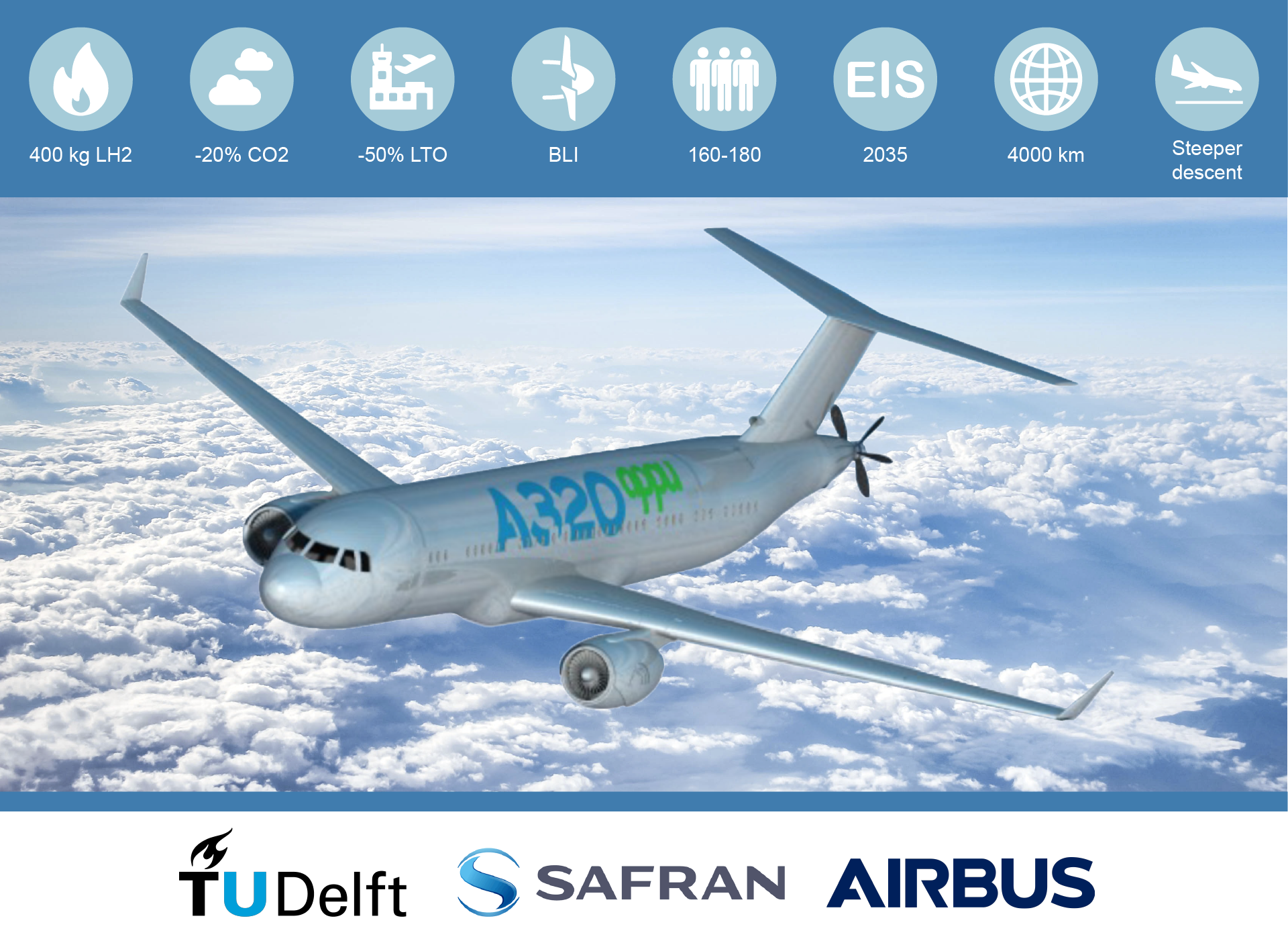Objectives
What is the project
The EU Flight Path 2050 Goals aim at dramatically reducing the climate impact of aviation. While drastic changes in the aircraft configuration are only possible in the latter half of this century, the climate impact of aviation has to be tackled soon. The APPU project aims at significantly cutting local air emissions while significantly reducing the global impact of aviation by introducing “Energy Mix” into aviation and enhancing aircraft efficiency by application of novel boundary layer ingestion (BLI) technology to the workhorse of aviation, the A320, thereby reducing the risks and the time to market introduction drastically. The proposed APPU is a novel system that replaces the traditional APU with a multifunctional state of the art gas turbine fuelled by Hydrogen and powering a variable pitch open rotor propulsion system at the aft end of the fuselage in a BLI configuration.
Why is it important (for society, industry)
The short to medium rage (SMR) aircraft, like A320, are the backbone of civil aviation and are therefore responsible for a significant portion of emissions from aviation (35-40%). While small aircraft can be made electric or hybrid electric, these solutions are not scalable and are not applicable to aircraft like A320 family. The APPU project will introduce energy mix in aviation by allowing a scalable, feasible, producible and economical aircraft that will use hydrogen in a synergistic way along with other innovative technologies. The APPU system that will be developed in the project has the potential to cut LTO emissions by half.
Project goals
- Design a BLI system for A320 type of Aircraft
- Design and test an open rotor propulsion system operating in boundary layer ingestion regime
- Design and test a hydrogen combustor for the APPU engine
- Design and optimize the aircraft empennage and performance for next generation A320 with the APPU system
- Investigate storage solutions for H2 in an aircraft
Advantages of the APPU System
- CO2 Free Propulsion: The thrust produced by APPU is free of CO2/soot/UHC/CO emission.
- Emission Free Taxiing: Substantial reduction in local airport emissions as taxing can be done by the aft propulsor.
- Drag Reduction: The aircraft drag can be reduced due to the wake filling from the aft propulsor thereby resulting in lower fuselage/empennage drag.
- Improved Main Engines: Since the APPU system is capable of providing CO2 free auxiliary power on a continuous basis, there is no need for power off-take or bleed off-take from the main engines, thereby improving the main engine operating characteristics.
- Improved Ground Operations: The BLI thrust reverser can also be used during static conditions (unlike the main engines podded under the wings), thereby eliminating the need to tug the aircraft out of its parking area. This reduces operational costs substantially.
- Improved Landing Distance: The BLI fan with a variable pitch mechanism is very well suited to work as a thrust reverser, thereby reducing the aircraft landing distance.
- Steeper Descent: The BLI propulsor could also be used as an air-brake due to its placement with the aircraft centreline in order to assist with a steeper aircraft descent. This would be beneficial in reducing the noise footprint near airports while approaching.
- Improved Handling Qualities: The constraints on the aircraft design with the “one engine out condition” become less severe due to the addition of an independent aft propulsor.
- Improved Reliability: The operating envelope of the APPU system is enlarged due to H2 combustion. Also since the APPU system will operate throughout the flight, the availability of emergency power is always ensured. This would enhance the reliability of the aircraft.
- Minimal Design Changes: The APPU system can be incorporated in the next generation of aircraft without significantly changing the aircraft geometry or its production line.
When can we see results from the project? And what results are you hoping for?
The preliminary studies already indicate that with the synergistic exploitation of BLI and Hydrogen combustion, the CO2 emission for a typical 2000km flight can be reduced by around 20% and the LTO emissions can be reduced by around 50%. Over the course of the project, subsystems will be designed and some of the critical technologies such a hydrogen combustor and scaled boundary layer ingestion propeller will be tested in the labs of the faculty of aerospace engineers in TU Delft. These tests will provide valuable data which will subsequently be used to refine the design and to improve the predictions.
Is there a call to action for the reader? Can people participate in any way?
Support and embrace energy transition. This is one of the best ways of fighting climate change. People can participate in some of the dissemination events. The technical details of the project are not fully open in view of the commercial IP of the project. The APPU project will play a defining role in the next generation of A320 that is expected to enter into service in 2035.
